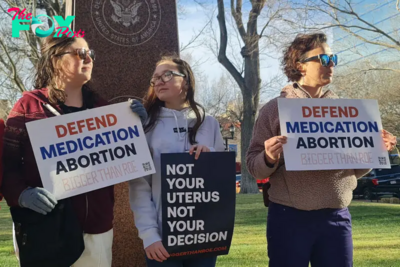Politics
Wealthier, urban Americans have access to more local news – while roughly half of US counties have only one outlet or less
Is local news readily available in your town? Do reporters still cover your school board and other municipal meetings?
If you answered yes, you are likely wealthier than the average American, and you live in or near a metro area.
The State of Local News Project at Northwestern University documents the changing local news landscape across the country. Our latest report shows that where you live and how much money you make affect whether you live in a news desert or a news oasis. This divide is related to other factors affecting the health of our democracy, as analysis of our data by the nonprofit Rebuild Local News showed.
For more than a decade, I have worked in organizations that study and support local journalism, and I’m intimately familiar with both the challenges and the solutions for the local journalism landscape.
Inequity in local news
One of the most vexing problems, as our report shows, is the persistence of inequity between communities that are local journalism haves and have-nots.
The have-nots are news deserts with few, if any, journalists to do the daily newsgathering and reporting that people require to participate meaningfully in their local communities and democratic institutions.
The main challenge for news outlets in have-not communities is the migration of advertising money from the printed page – where it made up roughly 80% of news organizations’ income – to the screen, where it now makes up less than 20%. This decline in ad revenue, a trend for the last decade-plus, has forced many outlets to rely on audience funding, philanthropy, cost-cutting or some combination of the three.
In communities with little disposable income to put toward news subscriptions or donations and no local philanthropies, cost-cutting becomes the only option. This creates a self-reinforcing spiral of lower quality and declining readership and, ultimately, closure.
In 2023, the country lost more than 130 print newspapers, which continue to be the newsrooms most likely to produce original local content that other outlets circulate.
Since 2005, the U.S. has lost almost 2,900 papers.
New digital outlets are not being created fast enough to fill that huge void. The number of digital outlets has held steady at roughly 550 in recent years, with about 20 new outlets opening each year – and roughly the same number closing.
All told, 1,558 of the nation’s 3,143 counties have only one news outlet, while 203 are news deserts with zero, meaning there are likely thousands of communities that simply do not have access to local news.
For example, both Texas and Tennessee had four counties lose their only remaining newspaper last year. All eight papers were independently owned.
What it takes to thrive
Wealthier communities do better sustaining local news organizations.
Our data shows that counties with an average household income over US$80,000 can support a robust local journalism ecosystem – meaning 10 or more outlets. Those with an average household income of $54,000 or less are more likely to be news deserts. By the same token, the percentage of the population below the poverty line in news deserts averages more than 16%, versus 12% in counties with robust markets. This finding aligns with other research, including a previous study I did of local news in New Jersey.
In addition to household income, population density correlates to the number of outlets serving a local community. In our data, counties with 10 or more outlets are overwhelmingly urban or dense suburbia, while news deserts are usually rural – though news deserts also occur in low-income pockets of metro areas. Densely populated communities tend to include higher-income households and have network effects that come from the ability of businesses to reach a larger number of people in a relatively small footprint.
This phenomenon leads to the third factor related to number of outlets in a county: gross domestic product per capita. In any town, city or country, the GDP represents the amount of money netted from sales of services and merchandise, divided by population. For the news oases in our study, the average GDP per capita is $75,140. For the news deserts, it is just $8,964. This difference reflects the retail and services base, and the number of Businesses that could buy advertising in their local news outlet, or create jobs that would allow residents to donate to one.
An example that highlights the importance of this factor is the newspaper Moab Sun News, which is thriving in the rural rocky highlands of Utah, thanks in part to a robust tourism industry and retail base. Though it serves a relatively small permanent population of 5,321, the Moab Sun News has built a sustainable business model through strong advertising revenue, a user-friendly website that welcomes subscriptions and donations, and creative collaborations with other community organizations in town.
The final factor that contributes to a community being a journalism have or have-not is access to high-quality broadband. Emerging metrics show that this near-necessity of contemporary life is not yet reliably available to rural Americans.
What’s working
Despite these seemingly intractable problems, solutions to local journalism inequality are becoming clearer.
One is collaboration. For example, in Colorado, the national nonprofit news outlet The Daily Yonder has hired a reporter based in a rural community to write stories about life there and share them out with both local and national organizations.
Another is philanthropy. The new Press Forward initiative has begun local chapters across the country, with at least one planning to serve rural communities. Organizations like the National Trust for Local News have been buying outlets that would likely otherwise be sold to hedge funds, and turning them into nonprofits that will continue to serve their communities.
Public policy should also play a role. At the state level, policies to support local news have seen success in New Jersey, California and elsewhere, and more bills are working their way through state legislatures. People seem to be realizing that having quality local news is just as vital as having public education and access to health care. With any luck, every community will have the opportunity to be a journalism “have.”
-

 Politics14h ago
Politics14h agoWhy Trump Actually Needs Mexico
-

 Politics14h ago
Politics14h agoMan Convicted of Killing Laken Riley Sentenced to Life in Prison Without Parole
-

 Politics20h ago
Politics20h agoHow the Biden Administration Protected Abortion Pill Access—and What Trump Could Do Next
-

 Politics20h ago
Politics20h agoWhy Trump’s Tariffs Could Raise Grocery Prices
-

 Politics1d ago
Politics1d agoThe First Trans Member of Congress Expected Pushback Like Mace’s Bathroom Rule
-

 Politics1d ago
Politics1d agoNew York Prosecutors Oppose Dismissing Trump’s Hush Money Conviction
-

 Politics1d ago
Politics1d agoWhite House Christmas Tree Is a Symbol of Resilience for Hurricane-Hit North Carolina Farms
-

 Politics2d ago
Politics2d agoHakeem Jeffries Wins Reelection as House Democratic Leader Despite Party’s Losses





















